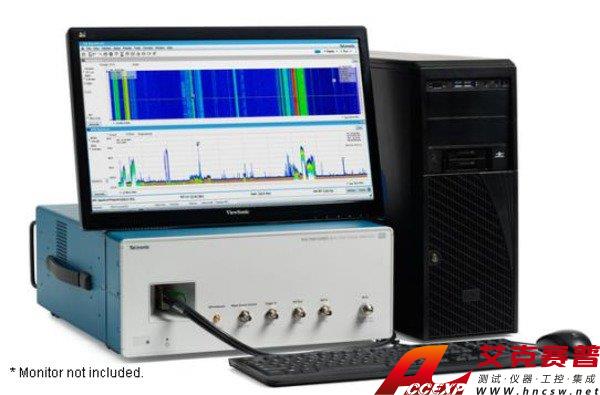
The RSA7100B wideband signal analyzer offers real time spectrum analysis up to 800?MHz bandwidth, simultaneous streaming to multiple interfaces for record (up to 2?hours) and playback of seamless data at full bandwidth.
Key features
-
16?kHz to 14/26.5?GHz frequency range
-
High performance spectrum analysis for advanced design verification with -134?dBc/Hz phase noise at 1?GHz, 10?kHz offset and typical amplitude accuracy of 0.5?dB at 10?GHz
-
Standard 320?MHz real time bandwidth; standard internal preamplifier to 3.6?GHz
-
Industry's best real time performance: 232?nsec for 100% Probability of Intercept at full signal level
-
Available 800?MHz acquisition bandwidth at frequencies > 3.6?GHz for advanced Radar, communications and spectrum management requirements
-
Industry-leading time-qualified triggers which enable capture of events at desired pulse widths > 10?μs, ideal for capturing dynamic test environments
-
IQFlowTM provides continuous streaming of IQ data at full 800?MHz bandwidth from the device to one or more clients, including LVDS, 40?GbE, and a software API that provides the speed and flexibility needed to perform real-time Digital Signal Processing (DSP) algorithms
-
Streaming capture to internal RAID of over 2?hours at full 800?MHz bandwidth enables environment recording and analysis of long event sequences
-
DataVu-PC software for analysis of recorded events of any length includes ability to mark events of interest, export waveforms to other formats and perform pulse analysis with export of Pulse Descriptor Word (PDW) information
-
Simultaneous streaming and real time analysis for live monitoring of recording events ensures you are getting the data you need
-
Efficient fast-frame capture with dead time eliminated optimizes memory and analysis so you can analyze longer test sequences
-
Standard measurements including channel power, ACLR, CCDF, OBW/EBW, spurious search and amplitude/frequency/phase versus time provide a complete toolset for development work
-
Internal GPS receiver, 1PPS and IRIG-B AM/DC are available for precise time stamping of events
-
Standard real time DPX(R) spectrogram technology lets you see short-duration signals on a color-coded display. See the transients and interference your conventional spectrum analyzer is not showing you.
-
SignalVu-PC vector signal analysis software provides a wide variety of analysis packages, including modulation, pulse, WLAN, phase noise, and frequency/phase settling measurements.
Applications
-
Advanced radar/EW design evaluation
-
Environment evaluation, monitoring, and recording
-
Wideband communications design
-
Spectrum management
-
Electromagnetic environmental effects (E3)
-
Military range testing and field operations
Discover through color
The patented DPX? spectrum processing engine brings live analysis of transient events to spectrum analyzers. Transients of a minimum event duration of 0.232?μs in length are displayed in the frequency domain. This is orders of magnitude faster than swept analysis techniques. The large amount of data is color coded by rate of occurrence onto a bitmapped display, providing unparalleled insight into transient signal behavior. The DPX spectrum processor can be swept over the entire frequency range of the instrument, enabling broadband transient capture previously unavailable in any spectrum analyzer.
The RSA7100B gives you the power to imagine new solutions
The RSA7100B is a high performance spectrum analyzer focused on wideband analysis and signal recording. By separating the RF acquisitions from the compute engine, a graphics processor can be used in place of previously-required FPGA designs for real time processing.
You can harness the power of this CPU/GPU combination in your own simulations and designs, using the instrument as a powerful workstation.
The RSA7100B is designed for engineers working on the latest wideband designs in communications, radar and electronic warfare and for technicians who need to capture and analyze long-event sequences for wideband systems at the test range.
Analysis of signals is enabled with two software packages. SignalVu-PC for real time, spectrum and vector signal analysis, and DataVu-PC for analysis of the very large file sets produced when recording wideband signals.
SignalVu-PC software offers rich analysis capability
The RSA7100B operates with SignalVu-PC, a powerful program used as the basis of Tek's spectrum analyzers. SignalVu-PC offers a deep analysis capability including real time spectrum analysis and a wide variety of application packages. A programmatic interface to SignalVu-PC is provided, offering all measurements and settings to external programs.
The RSA7100B combined with SignalVu-PC application licenses offers advanced analysis, 800?MHz bandwidth, streaming to internal RAID for record and playback, and simultaneous streaming to multiple interfaces for custom DSP simulations
SignalVu-PC offers a wealth of application-oriented options, including:
See the separate SignalVu-PC data sheet for complete details and ordering information. Selected applications are illustrated below.
Pulse analysis
The Pulse Analysis package (SVPH) provides 29?individual measurements plus cumulative statistics, opening a world of characterization for wideband pulsed system designers and evaluators. The fast-frame acquisition mode of SignalVu-PC with the RSA7100B allows you to acquire just the time of interest during your pulse, making the most efficient use of memory. Cumulative statistics displays analyze data over multiple acquisitions, further extending the analysis to millions of pulses. Displays and measurements include:
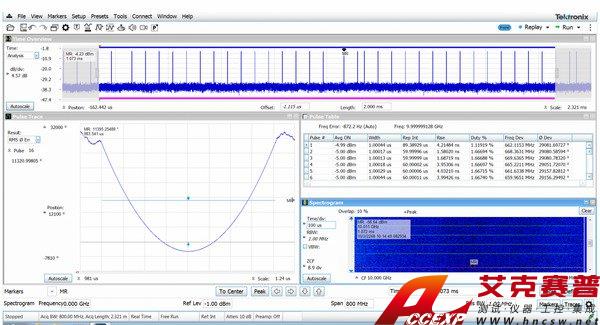
Shown above is a 700?MHz wide chirped signal. A time overview is presented at the top of the display that shows the pulses in the current acquisition. Phase deviation is displayed on the left, showing the characteristic parabolic shape of a frequency chirp. The signal has variations in repetition interval, shown in both the pulse table and the spectrogram on the right.
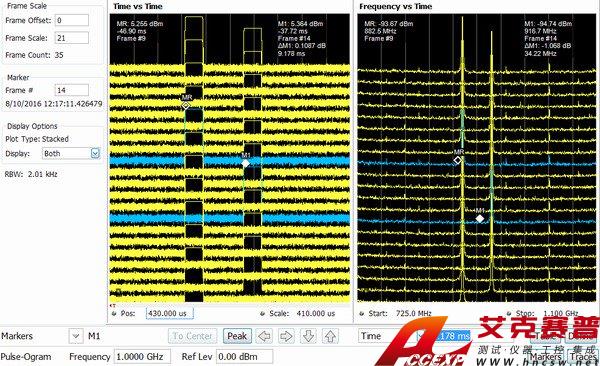
The illustration above is the unique Pulse-Ogram display in SignalVu-PC application license SVPH. This is a waterfall of triggered pulses showing their relationship to the trigger in time domain. Variations are immediately seen as changes in timing vs. trigger. Each time domain trace is represented as a spectrum on the right side of the display for immediate correlation of time and frequency domain effects.
General purpose modulation analysis
SignalVu-PC application SV21 bundles 27?different modulation types into a single analysis package that includes:
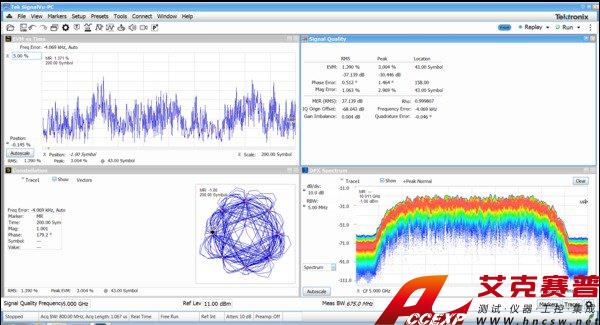
In the illustration above, a 5?GHz carrier modulated with 500?MSymbols/sec pi/4-QPSK is analyzed with the RSA7100B Option B800 and SignalVu-PC application license SVMH. A measurement summary, EVM vs. Time, and constellation display are shown along with the continuous monitoring of the DPX spectrum.
Streaming recording to RAID
With option STREAMNL-SVPC, you can stream the full real time bandwidth of the RSA7100B to the RAID system. All other analysis (real time spectrum analysis, modulation analysis, etc.) is available simultaneous with streaming. This ability to analyze while streaming ensures the integrity of your data collection, avoiding re-runs, and saving time.

Easy recordings are available at the touch of a button or when a trigger is received. Anticipated file size is reported and indications of skipped frames or overload conditions are provided to ensure high-quality recording. Above we see a 5?second recording being made. DPX spectrum is providing real time monitoring of the 800?MHz acquisition. The file size, available disk space, recording progress, number of files recorded are all reported. Indicators of dropped frames and input overload are presented all in the same control screen.
DataVu-PC for analysis of long recordings
SignalVu-PC can open files up to 16?GB in size. DataVu-PC is the solution for analysis of large files. With DataVu-PC you can view color-graded spectrums, spectrograms and amplitude vs. time of files of unlimited length. Search-and-mark testing is available to quickly identify signals of interest. Searches can be amplitude qualified, and a marker is placed on up to 2,000,000?events found. Replay of user-selected sections is offered for review of signals of interest, and selected areas can be exported to SignalVu-PC for further analysis. Pulse analysis is available within DataVu-PC. See the separate DataVu-PC data sheet for complete details and ordering information.
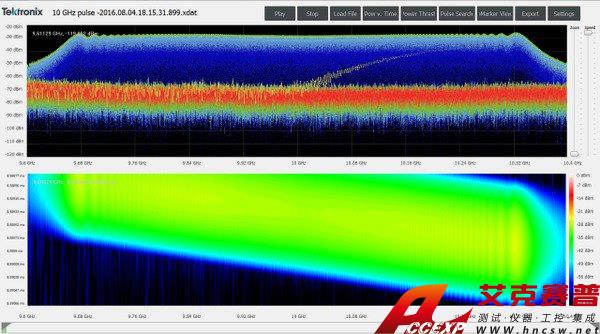
Above is a color-graded spectrum display combined with a 99% overlap spectrogram display as shown on DataVu-PC. You have full overlap/skip control to vary rate and detail of the streaming file for complete visualization of the data.
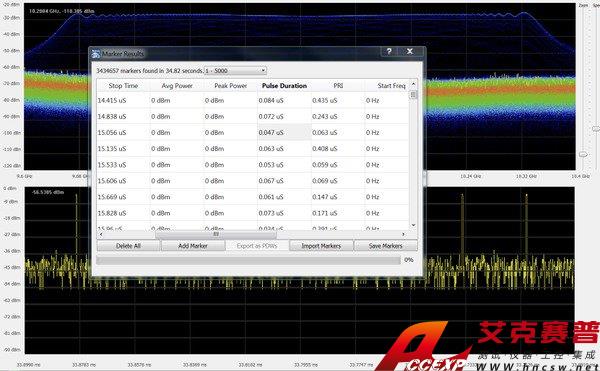
DataVu-PC pulse option provides fast marking of pulses and measurements on large data sets. Above, the results of a pulse search are presented with the pulse measurements of start/stop time, average/peak power, pulse duration, Pulse Repetition Interval (PRI) and start/stop frequencies on up to 2,000,000?pulses. Pulse results can be exported in PDW format for use by other tools.
Automated phase noise and jitter measurements
Phase noise degrades the ability to process Doppler information in radar systems and degrades error vector magnitude in digitally modulation communication systems. Automated phase noise and jitter measurements with a spectrum analyzer (PHAS) may reduce the cost of your measurements by reducing the need for a dedicated phase noise analyzer.
Shown below, the phase noise of a 1?GHz carrier is measured at -133?dBc/Hz at 10?kHz offset. Single-sideband phase noise is displayed in dBc/Hz versus offset frequencies from carrier, shown in trace or tabular form: one ±Peak trace (in blue) and one average trace (in yellow). Trace smoothing and averaging is supported.
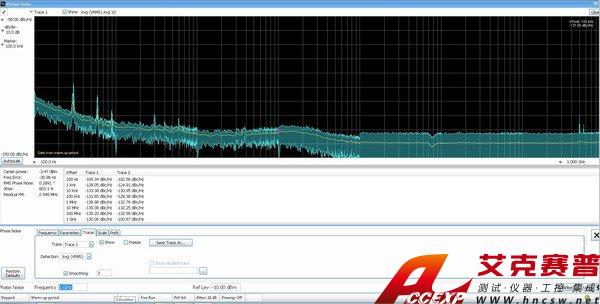
The RSA7100B's intrinsic phase noise of -134?dBc/Hz, at this frequency and across its operating range, provides ample measurement margin for a vast majority of applications.
Applications include testing VCO phase noise, oscillator phase noise, clock source jitter, signal generator phase noise, and more. The Tektronix phase noise / jitter application, when combined with DPX? signal processing, provides a powerful solution for designing and troubleshooting momentarily unstable signal sources.
The phase noise application performs automated carrier tracking, averaging, and dynamic measurement bandwidth adjustment, providing the accuracy and speed of measurement needed at all carrier offsets - ranging from 10?Hz to 1?GHz. Results are available in log-frequency trace or tabular form with pass/fail limits on-screen or via programmatic control. Integration limits are programmable for RMS phase noise, jitter, and residual FM. The low instrument phase noise of the RSA7100B together with this measurement application allows for high-performance phase noise measurements at frequencies up to 26.5?GHz.
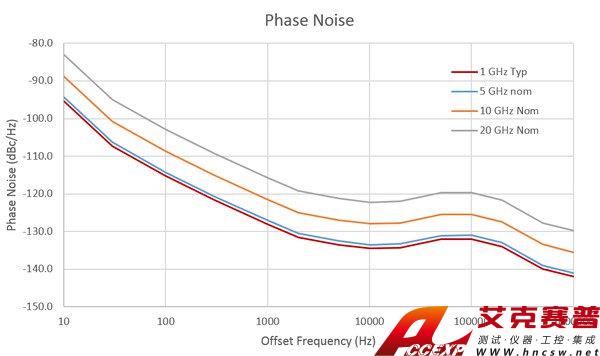
The previous figure shows the RSA7100B typical and nominal phase noise performance.
CTRL7100B controller included with the RSA7100B
Tektronix has designed the CTRL7100B controller to meet the specified performance of real time DPX operation with simultaneous streaming to RAID storage and external client interfaces. With the available software API, you can also harness the power of this CPU/GPU combination to host your own simulations and designs, using the instrument as a powerful workstation.
CTRL7100B key specifications
The CTRL7100B is offered in the following configuration. See the CTRL7100Bdatasheet for full specifications of the controller.
-
Dual Intel? Xeon? Gold 5218?16?Core (Cascade Lake)
-
512?GB SSD (removable)
-
Optional RAID controller and front-panel removable drives supports 4?GB/s and up to 32?TB
-
Windows 10?operating system, compliant to US DoD's STIG
-
GPU: AMD WX9100
-
40?GbE card